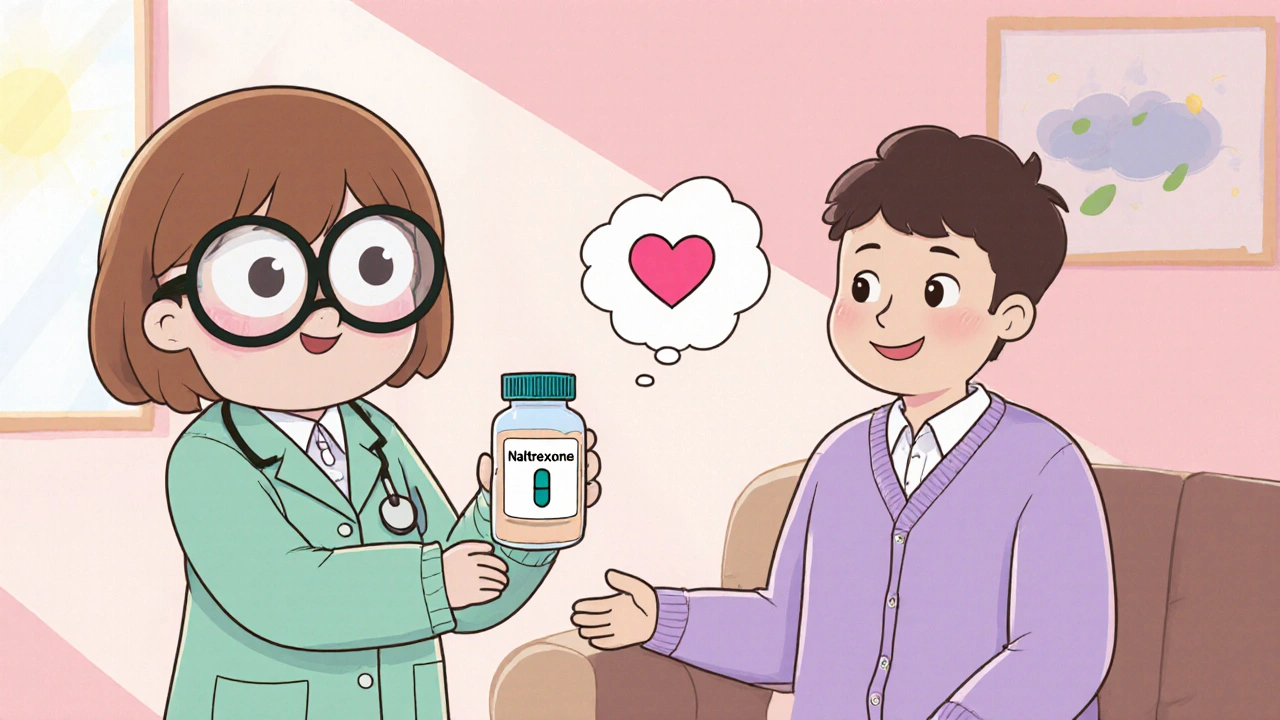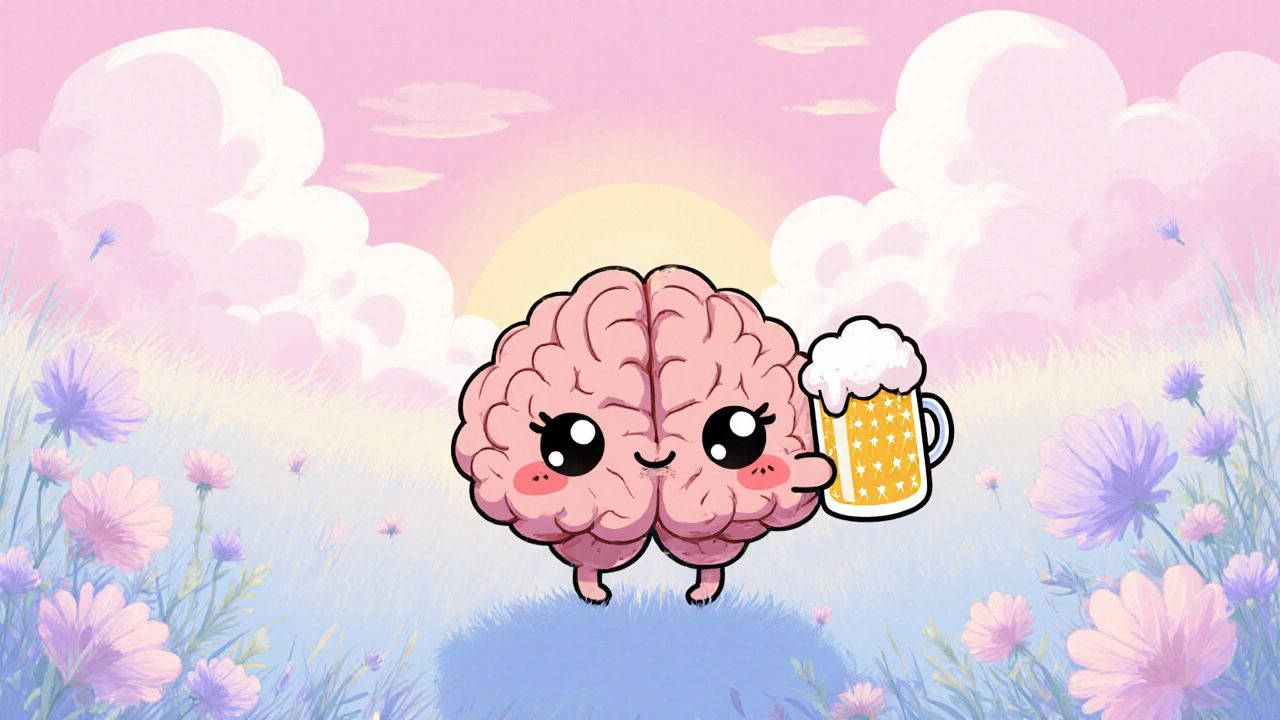AUDIT Screening Tool: Alcohol Dependence Risk Assessment
Alcohol Use Disorders Identification Test
This clinical screening tool identifies risky drinking patterns before dependence develops. Based on WHO guidelines.
Alcohol Dependence Syndrome is a chronic brain disorder characterized by an inability to control drinking despite harmful consequences. It involves a mix of physiological, genetic, and environmental factors that push the brain into a state of compulsive alcohol use. Understanding why the brain reacts this way helps doctors and families break the cycle and choose the right treatment.
What exactly is Alcohol Dependence Syndrome?
In everyday language, people often use "alcoholism" or "alcohol addiction" interchangeably, but the clinical term focuses on a pattern of behavior and neuro‑biological changes. According to the World Health Organization (WHO), dependence is marked by a strong desire to drink, difficulty controlling intake, withdrawal signs, and tolerance. The syndrome is listed in the DSM‑5 as Alcohol Use Disorder when the criteria reach a certain threshold.
Brain chemistry: how alcohol rewires the reward system
When you take a sip of beer, the brain releases a flood of dopamine in the nucleus accumbens. That feeling of pleasure is what makes the first drink enjoyable. Over time, repeated exposure forces the brain to adapt: GABA receptors become less sensitive, glutamate activity ramps up, and the natural production of dopamine drops. The result? The brain now needs more alcohol just to feel normal - that’s tolerance - and the reward from drinking becomes the only way to chase the lost dopamine high.
- Dopamine: fuels the “wanting” part of reward.
- GABA: the main inhibitory neurotransmitter; alcohol enhances its effect, creating the calming sensation.
- Glutamate: excitatory; chronic drinking up‑regulates it, leading to hyper‑excitability during withdrawal.
These shifts turn casual drinking into a physiological need, because the brain has rewired itself to expect alcohol’s presence.
Genetics and other risk factors
Not everyone who enjoys a weekend drink ends up with dependence. Studies of twins and families show that about 40‑60 % of the vulnerability comes from genetics. Specific genetic polymorphisms - like variants in the ADH1B and ALDH2 enzymes - affect how fast alcohol is broken down, influencing both the intensity of intoxication and the risk of dependence.
Beyond genes, early life stress, peer pressure, and easy access to cheap alcohol all stack on top of the neuro‑chemical changes. Think of it as layers: genetics lay the foundation, environment builds the walls, and brain chemistry adds the roof.
From casual use to dependence: the stages
The transition isn’t sudden. Researchers break it down into three overlapping phases:
- Experimentation - occasional drinking, often socially driven.
- Regular use - patterns emerge, tolerance starts, and drinking becomes a coping tool.
- Dependence - cravings dominate, withdrawal appears when drinking stops, and life’s priorities shift around alcohol.
During the regular‑use phase, the brain’s reward circuit starts treating alcohol like a drug, and the prefrontal cortex-responsible for decision‑making-gets hijacked. This is why people with dependence often say they “just can’t stop,” even when they know it’s harmful.

Clinical criteria: DSM‑5 vs. ICD‑10
| Criterion | DSM‑5 (Alcohol Use Disorder) | ICD‑10 (Alcohol Dependence Syndrome) |
|---|---|---|
| Number of criteria needed | 2‑3 = mild, 4‑5 = moderate, ≥6 = severe | At least 3 of 6 |
| Core symptoms | Craving, loss of control, continued use despite problems | Strong desire, difficulty limiting, withdrawal, tolerance |
| Withdrawal specification | Explicitly listed as a criterion | Implicit within “physiological features” |
| Emphasis on psychosocial impact | High - includes occupational, legal, relational issues | Moderate - focuses on physical dependence |
| Diagnostic coding | F10.2‑F10.9 (varied severity) | F10.2 (dependence syndrome) |
Both systems aim to capture the same reality, but the DSM‑5 gives clinicians more granularity for treatment planning, while ICD‑10 provides a simpler, globally recognized label.
Health impacts beyond the brain
Alcohol dependence doesn’t stay locked in the mind-it spreads to the liver, heart, and even the immune system. Chronic heavy drinking leads to fatty liver, which can progress to cirrhosis in 10‑15 years for many patients. Cardiovascularly, it raises blood pressure and can cause atrial fibrillation. Neurologically, long‑term exposure shrinks gray matter in the frontal lobes, worsening decision‑making and memory.
And don’t forget the social toll: missed work, relationship breakdowns, and legal problems pile up, feeding the vicious cycle of stress‑driven drinking.
Treatment options: medication and therapy
Breaking the cycle requires a two‑pronged attack-address the chemistry and rebuild healthier habits.
Pharmacotherapy
- Naltrexone - an opioid antagonist that blunts the rewarding effects of alcohol, reducing cravings. Typical dose: 50 mg daily.
- Acamprosate - helps restore the balance between glutamate and GABA, easing post‑detox cravings. Usually 666 mg three times a day.
- Disulfiram - causes unpleasant flushing if alcohol is consumed, acting as a deterrent. Used when motivation is high.
Psychotherapy
Evidence‑based approaches like Cognitive Behavioral Therapy (CBT) teach patients to recognize triggers and develop coping skills. Motivational Interviewing (MI) works well in the early stages, helping ambivalent drinkers find personal reasons to change.
Combining medication with therapy yields the best outcomes-up to a 60 % increase in abstinence rates compared to either approach alone.

Managing withdrawal safely
Stopping heavy drinking cold can trigger seizures, delirium tremens, and severe autonomic instability. Medical detox programs use benzodiazepines (like lorazepam) to smooth the GABA‑glutamate rebound, while monitoring vital signs closely. Most patients stay in a supervised setting for 3‑5 days, after which they transition to outpatient counseling.
Key withdrawal symptoms to watch for:
- Tremors and anxiety
- Insomnia and vivid dreams
- Hallucinations (visual or tactile)
- Seizures (usually within 48 hours)
- Delirium tremens (peak at 72‑96 hours)
Prompt medical attention cuts the risk of complications dramatically.
Prevention and early intervention
Screening tools like the AUDIT (Alcohol Use Disorders Identification Test) catch risky drinking before it turns into dependence. Primary‑care physicians who ask about drinking habits and provide brief advice can reduce the progression rate by roughly 25 %.
Community programs-college‑based education, workplace wellness, and responsible‑serving training for bartenders-also shift cultural norms, making it easier for people to say “no” when they feel pressure.
Key takeaways
- Alcohol Dependence Syndrome is a brain‑based disorder driven by dopamine, GABA, and glutamate changes.
- Genetics accounts for up to half of the vulnerability; environment and stress add the rest.
- DSM‑5 and ICD‑10 offer slightly different diagnostic lenses but agree on core features.
- Effective treatment blends medication (naltrexone, acamprosate, disulfiram) with evidence‑based therapy (CBT, MI).
- Medical detox is essential for safe withdrawal; never quit “cold turkey” after heavy use.
Frequently Asked Questions
Can someone be “addicted” after just a few drinks?
Addiction usually develops after repeated heavy use, but a genetic predisposition can make a person more vulnerable even after relatively low exposure. Most experts look for patterns of tolerance, cravings, and withdrawal before labeling it dependence.
Is there a cure for alcohol dependence?
There’s no single “cure,” but many people achieve long‑term sobriety with a combination of medication, therapy, and lifestyle changes. Ongoing support groups and regular follow‑ups improve success rates dramatically.
How does naltrexone actually work?
Naltrexone blocks opioid receptors that alcohol indirectly activates. By cutting off that secondary reward pathway, the drink feels less pleasurable, which reduces cravings and the urge to keep drinking.
What’s the difference between withdrawal and a hangover?
A hangover is a short‑term reaction to a single binge-headache, nausea, and fatigue. Withdrawal occurs after regular heavy use stops and can involve tremors, seizures, or delirium tremens, which are medical emergencies.
Can I prevent dependence if I already drink weekly?
Yes. Monitoring your intake, using a drinking diary, and setting limits can help. If you notice increasing tolerance or cravings, seeking a brief counseling session early can keep the habit from escalating.

 Oct, 18 2025
Oct, 18 2025

Poornima Ganesan
October 18, 2025 AT 19:15The ADH1B and ALDH2 variants are not just academic footnotes, they actually dictate how fast your body metabolizes ethanol.
People with the fast‑acting ALDH2*2 allele often feel intense flushing, which can act as a natural deterrent.
Conversely, carriers of the slower ADH1B*2 allele tend to experience higher acetaldehyde buildup, leading to more severe hangovers and, paradoxically, a higher risk of dependence if they keep drinking.
Genetics alone doesn’t seal your fate, but it sets a baseline that environmental stressors can easily amplify.
That’s why early‑life trauma combined with a vulnerable genotype is a perfect storm for the syndrome.
Bottom line: you can’t blame the brain alone; the whole picture matters.
Emma Williams
November 2, 2025 AT 14:13Absolutely the genetics part is spot on
Stephanie Zaragoza
November 17, 2025 AT 10:12When ethanol enters the synaptic cleft, it binds to the GABAA receptor complex, enhancing chloride ion influx; this hyper‑polarizes neurons and produces the characteristic sedative effect.
Repeated exposure leads to down‑regulation of GABAA subunits, meaning the brain needs more alcohol to achieve the same inhibitory tone.
Simultaneously, chronic drinking up‑regulates NMDA‑type glutamate receptors, heightening excitatory drive during withdrawal, which manifests as tremors, anxiety, and even seizures.
Dopamine release in the nucleus accumbens is initially massive, but with prolonged use the mesolimbic pathway adapts, reducing baseline dopamine synthesis and blunting reward from natural stimuli.
Consequently, individuals experience anhedonia when sober, compelling them to drink merely to feel normal.
The interplay between these three neurotransmitter systems-GABA, glutamate, and dopamine-creates a vicious feedback loop that entrenches dependence.
From a pharmacological standpoint, naltrexone acts by antagonizing opioid µ‑receptors, indirectly dampening dopamine surges associated with alcohol consumption.
Acamprosate, on the other hand, modulates the glutamatergic system, aiming to restore the excitatory‑inhibitory balance disrupted in withdrawal.
Disulfiram’s mechanism is peripheral; it inhibits aldehyde dehydrogenase, causing acetaldehyde accumulation and severe aversive reactions if alcohol is consumed.
Clinically, the choice among these agents hinges on patient motivation, comorbid conditions, and prior treatment response.
Psychotherapy, especially Cognitive‑Behavioral Therapy, equips patients with coping strategies to manage cravings and high‑risk situations.
Motivational Interviewing helps resolve ambivalence, fostering intrinsic motivation for change.
Combined pharmacotherapy and behavioral therapy consistently outperform monotherapy in achieving sustained abstinence.
Moreover, regular monitoring with tools like the AUDIT can detect risky patterns early, allowing for timely intervention before full‑blown dependence sets in.
Ultimately, a nuanced, biopsychosocial approach-integrating neurochemical insights, genetic risk profiling, and psychosocial support-offers the best chance for recovery.
James Mali
December 2, 2025 AT 06:11If you think a table of neurotransmitters will cure anyone, you’re kidding yourself 😒
Rajesh Singh
December 17, 2025 AT 02:09Let’s be clear: celebrating endless binge‑drinking as a rite of passage is a moral abyss masquerading as tradition.
When you glorify intoxication, you implicitly endorse a culture that profits from the misery of addicts and their families.
The colorful language you use to describe "a good night" hides the stark reality of shattered lives, broken relationships, and empty wallets.
We must call out this hypocrisy and demand responsible messaging that doesn’t romanticize a disease.
Only then can society begin to heal the wounds inflicted by such reckless glorification.